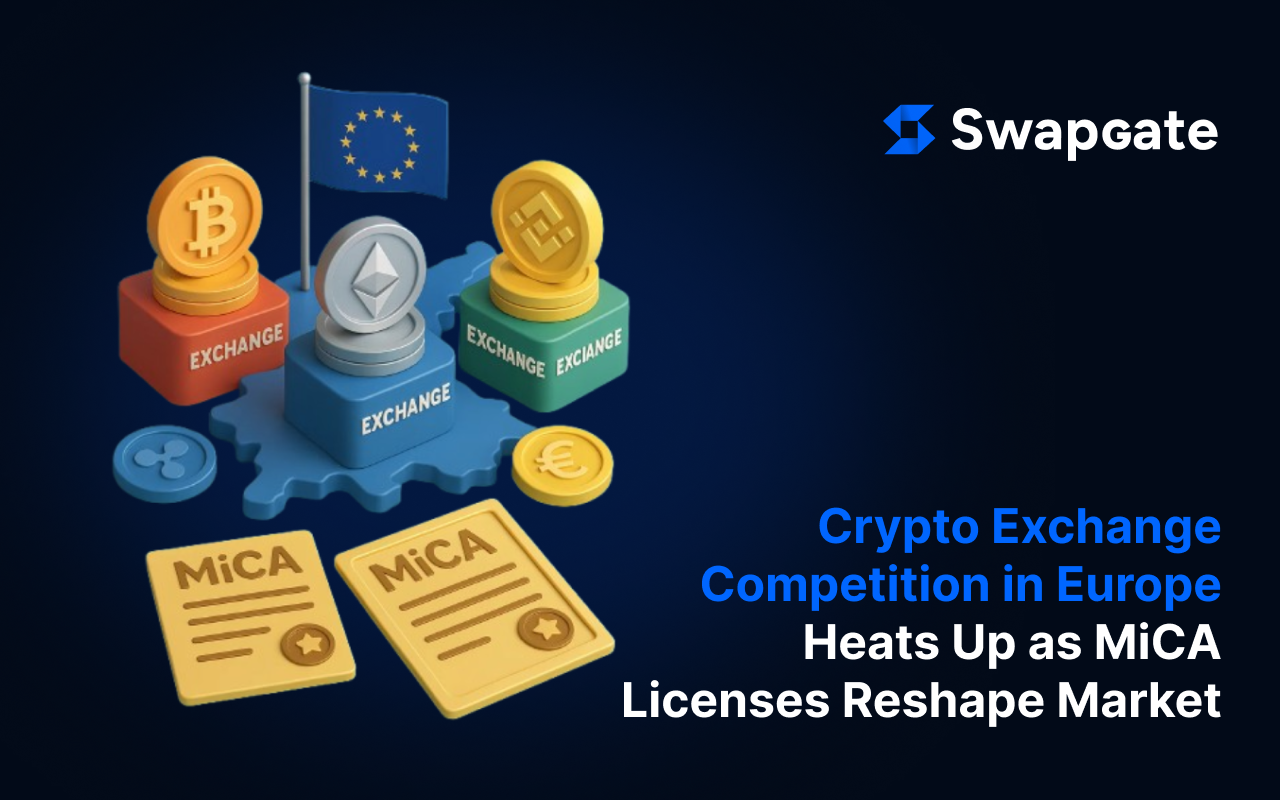
On June 28, 2025, crypto exchange Bitvavo secured a MiCA license from the Netherlands, joining giants like Coinbase, OKX, and Crypto.com in gaining regulatory approval to operate across the EU’s 27 member states. This surge in MiCA compliance exchanges signals a heated EU license race, reshaping the European market growth and boosting crypto adoption in Europe. Read about Crypto Exchange Competition here.
Why MiCA Licenses Matter
The Markets in Crypto-Assets (MiCA crypto regulation), fully effective since December 30, 2024, unifies crypto rules across the EU, replacing patchy national laws with a crypto regulation unified in EU. Exchanges with a MiCA license crypto exchange gain a MiCA pan-European passport, allowing seamless operations across all 27 EU countries plus Iceland, Liechtenstein, and Norway without separate licenses . This clarity fuels institutional interest in the EU and positions Europe as a leader in the regulated crypto environment.
User impact: For traders, MiCA benefits for exchanges mean safer platforms with stricter consumer protections, but some exchanges are delisting non-compliant stablecoins like Tether (USDT), potentially affecting trading options.
Key Players in the EU Crypto License Race
The crypto exchange competition in Europe is intensifying as major platforms secure MiCA compliance exchanges:
- Coinbase MiCA approval: On June 20, 2025, Coinbase became the first U.S. exchange to secure a MiCA license crypto exchange from Luxembourg’s CSSF, relocating its EU hub from Ireland. Coinbase now offers trading, custody, and merchant services to 450M EU users.
- OKX MiCA license: OKX gained its license from Malta, launching localized services (e.g., 60+ crypto-EUR pairs) for 400M+ users.
- Crypto.com Europe license: Them secured Malta’s approval, completing USDT delisting by March 31, 2025, to align with MiCA.
- Bybit MiCA registration: Bybit obtained its license from Austria on May 29, 2025, expanding its EEA footprint .
- Bitvavo: The latest entrant, licensed by the Dutch AFM, strengthens its position in the Netherlands.
| Exchange | MiCA License Country | Date Approved | Key Services |
| Coinbase | Luxembourg | June 20, 2025 | Trading, custody, merchant services |
| OKX | Malta | January 2025 | Localized trading, EUR pairs |
| Crypto.com | Malta | January 2025 | Trading, DeFi, staking |
| Bybit | Austria | May 29, 2025 | Spot and derivatives trading |
| Bitvavo | Netherlands | June 28, 2025 | Trading, wallet services |
MiCA Compliance Challenges and Stablecoin Delistings
MiCA and crypto competition isn’t without hurdles. Exchanges must meet strict requirements: licensing, consumer protection, and robust AML/KYC processes. Stablecoin issuers face reserve audits and whitepaper approvals, prompting delistings:
- Coinbase removed USDT and five stablecoins on December 13, 2024, with potential re-listing if compliant.
- Crypto.com and Kraken phased out USDT by March 31, 2025, causing a $2B market value drop for Tether.
User impact: Traders may face limited stablecoin options, but new crypto rules Europe ensure safer platforms. SwapGate users can still trade MiCA-compliant assets like USDC.
Europe Crypto Regulation Advantage
MiCA’s crypto regulation unified in EU offers a Europe crypto regulation advantage over the U.S., where fragmented state laws create uncertainty. EU’s Stefan Berger noted MiCA “brings a competitive edge” by fostering trust post-FTX collapse. A 70% surge in EU trading volumes in Q1 2025 reflects growing confidence .
MiCA vs US regulation: Unlike the U.S., where SEC lawsuits create legal gray zones, MiCA’s MiCA pan-European passport streamlines operations, attracting institutional interest EU.
Regulatory Arbitrage Concerns
The EU crypto license race has sparked debate. Smaller nations like Malta and Luxembourg issue licenses faster, raising fears of a “race to the bottom” in oversight of Decrypt. Malta licensed OKX, Crypto.com, and Gemini, while Luxembourg approved Coinbase, prompting scrutiny from France’s AMF and ESMA.
User impact: While exchanges entering the European market benefit from faster licenses, uneven enforcement could affect platform reliability. Choose exchanges with strong compliance records like SwapGate.
Consolidation of Crypto Exchanges in Europe
MiCA’s strict rules may drive consolidation of crypto exchanges in Europe. Smaller platforms struggle with compliance costs (e.g., AML upgrades, audits), potentially leading to mergers or exits. Larger players like Coinbase and OKX, with resources to adapt, are poised to dominate.
Broader context: The $3.3T global market sees Europe’s 450M users as a key growth area. MiCA’s clarity could double EU crypto adoption by 2027, per ESMA.
Looking Ahead: MiCA 2.0 Regulation?
The European Commission will review MiCA by mid-2025, potentially introducing MiCA 2.0 regulation to address NFTs, DeFi, and staking. ECB’s Christine Lagarde has pushed for tougher rules, but no concrete plans exist as of June 2025.
User tip: Stay updated on adoption in Europe via SwapGate’s news feed, as MiCA compliance challenges may shift available assets.
Conclusion
The crypto exchange competition in Europe is reshaping the market as MiCA compliance exchanges like Coinbase, OKX, Crypto.com, Bybit, and Bitvavo secure licenses, unlocking 450M users. MiCA benefits for exchanges include streamlined operations and trust, but delistings and compliance costs pose challenges. For users, new crypto rules in Europe mean safer trading but fewer stablecoin options. As European market growth accelerates, platforms like SwapGate offer a compliant gateway to this evolving landscape. Always verify platform licensing before trading.